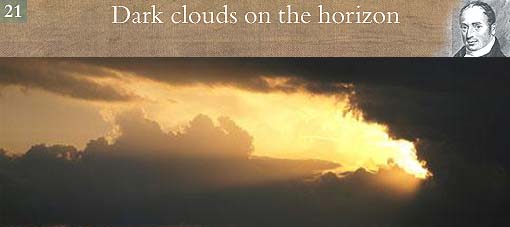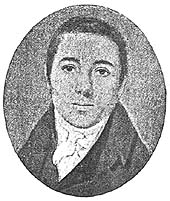

Copyright Getty Images. Moves to transfer the Society from Northamptonshire to London In April 1813, the missionaries at Serampore received official information of the modification to the Constitution of the Baptist Missionary Society. It had now been 20 years in existence and the chief authority rested with the man who had been the life and soul of the enterprise. Its seat was still in the county (Northamptonshire), that had been the cradle of the mission. Fuller was supported by 2 cabinet counsellors, Dr. Ryland of Bristol, and Dr. Sutcliff of Olney, and by a committee which met annually at Kettering. But other missionary societies that had been subsequently formed had their headquarters in London. A desire now arose, more especially among the London Baptists, to move the headquarters of the society to the capital. The desire was not unreasonable, but was manifestly connected with the hope of sharing power with the Secretary. It was, however more abundantly sharpened by the fire at Serampore, which disclosed the magnitude of the operations, and extended the reputation of the mission throughout the kingdom.
Society members were opposed to the change, associating its success, against formidable difficulties, with the control conceded to its great master spirit. Any arrangement that would affect this concentration of energy were regarded with mistrust. But, indirect hints were thrown out by London members from time to time, of the necessity of giving respectability to the mission by transferring it to the capital.
The best friends of the mission foresaw that it could not be much longer kept out of the hands of a London committee, whose intercourse with the missionaries in India would change from affectionate correspondence, to an abundance of resolutions. They were anxious to put off the evil day as long as possible.
Fuller and his colleagues resolved to meet the pressing demands by adding 19 new members to the committee. Of the 19, only 3 were from London. The plan was sanctioned on 29th September, 1812, and Fuller wrote to Serampore stating that the seat of the mission would, it was hoped, continue in the association in which it had originated. He said they had agreed to enlarge the committee, by adding to it brethren from different parts of the kingdom, who appeared best suited to the work, and had their hearts most interested in it.
In 1810, Carey had advised Fuller on the favourable change of the authorities in India under Lord Minto. When the letter arrived in England, no time was lost in sending Mr. Johns and Mr. Lawson to America, to then take the first ship to India. They were detained in America more than 12 months, during which time they revived interest in that country towards the missionary labours in Serampore, particularly the translations. They succeeded in raising £800 before embarking for Calcutta, which they reached on 15th August, 1812.
By this time, the Government's feelings towards missions had reverted to the old hostility. The Serampore missionaries felt no little alarm as they no longer had the shelter of a foreign flag. Marshman wrote to Mr. Elphinstone, the Chief Secretary to Government stating that Mr. Johns and Mr. Lawson might be shortly expected on an American vessel, and they were anxious to obtain permission for them to remain in India until the pleasure of the Court of Directors should be known. Mr. Elphinstone was directed by Lord Minto to inform them that the Government of India did not possess the power of granting licenses but did not object to their residence in India until a reference could be made to England.
Soon after the arrival of Mr. Johns and Mr. Lawson, the medical officer at Serampore left on account of his health, and Mr. Johns was directed to officiate for him.
Mr. Lawson presented himself at the Police Office in Calcutta on 13th March, 1813, where a form was drawn up by which he was to pledge himself to one of 2 vessels lying off Sagor, 100 miles below Calcutta. Marshman refused to allow Lawson to sign the form, and he was put in his palanquin, surrounded by a guard of native constables under charge of a European sergeant, and conveyed to the Kuttra, where persons under detention were normally locked up. Marshman went to the house of Mr. Ricketts and expostulated on the indignity of Lawson being conducted though the streets like a felon. Mr. Ricketts realised that matters had been pushed too far, and Marshman was able to return to Serampore that evening with Mr. Lawson.
On Tuesday, Marshman crossed the river to Barrackpore and requested an audience with Lord Minto. The Governor-General had always taken a lively interest in Marshman's Chinese labours and there appeared to be some faint hope of dwelling on Lawson's assistance in preparing the Chinese fount. In the evening Marshman prepared a letter dwelling particularly on Lawson's important services in preparing the Chinese type, and included specimens of tasteful and delicate workmanship.
Lord Minto declined the audience but agreed to let Lawson remain to complete the fount.
The native punchcutter eventually attained such perfection in his work that Lawson deemed it no longer necessary to give his time to this mechanical employment. In September 1815 he removed to Calcutta, with Eustace Carey, and they were appointed pastors at The Bow Bazaar church. Lawson was never able to master Bengali, but found ample scope for his ministerial gifts with the European and East Indian members of the congregation and the European soldiers in the fort.

Eustace Carey, from 'A History of Friar Lane Baptist Church', by Godfrey and Ward, 1903. Reproduced courtesy Nottingham City Libraries, Local Studies Library.
At the beginning of 1814, Fuller applied for a license for Rev. Eustace Carey to proceed to India. Eustace was the son of William Carey's brother, Thomas Carey. Thomas was a non-commissioned officer in the army and had served under the Duke of York in Holland, where he was wounded and awarded a small pension. The early ambition of Eustace was to wear a red coat like his father.
Eustace had been born in Paulerspury, and, while a child, his mother had moved to Northampton, where he attended the ministry of Dr. Ryland at the College Lane Chapel. Under the care of his mother, and his aunt Mary Carey, he advanced in Christian knowledge and was baptised, by Dr. Ryland, on 7th July, 1809. For long the thought of offering himself for the mission field had been ripening in his mind, and at a special church meeting on 15th August, 1809, the church approved the design of sending him as a missionary student to Mr. Sutcliff at Olney. There he pursued his studies with diligence and proceeded to Bristol Baptist College under Dr. Ryland.
His habits, owing to his weak health, were those of a recluse, but he gave the casual observer the impression there was a vital energy in the fragile form. His preaching had a special charm to it, the diction was original and striking, and the earnestness and pathos of his manner marked him out as one of the most gifted young men of his time.
The application for a license was granted without hesitation, one of the first missionary applications under the Charter Act of 1813, and he sailed in one of the Company's own vessels.
Eustace Carey arrived in Calcutta on 1st August, 1814. The ship was the first to convey the news of the Allies entry into Paris, and the close of the war that had devastated Europe for 20 years. The vessel sailed up the Hooghly with the electrifying message "Peace" emblazoned on her flags. The arrival of Eustace Carey was therefore rendered doubly welcome.
He proceeded to Serampore, where his talents, and the graceful flow of his pulpit eloquence, made him a general favourite. In September 1815, he became joint pastor at the church in Bow Bazaar, with Lawson. He had applied with diligence and success to the study of Bengali and was able to combine missionary labours with his pastoral duties during the remaining 8 years of his stay in India.
During the course of 1814, Fuller had also applied for a license for Mr. Yates to enter India, and this was accepted. Yates was an eminent linguist, and applied with such diligence to the cultivation of Oriental literature, under the tuition of William Carey, as to become second only to his master as a biblical translator.
With regard to mission stations the missionaries report there were 6 in Bengal with resident missionaries, and 4 with native labourers, 4 in the upper provinces, 1 respectively in Seurat, Burma, Ceylon and Amboyna. These stations were occupied by 8 missionaries sent from England (exclusive of the 3 senior missionaries), by 15 missionaries, either European or East Indian, who had been engaged in the country, and 27 native preachers and itinerants.

Click on the map to find out where mission stations had been established by 1815. The number baptised in 15 years had been 765, of whom more than two thirds were natives.
With regard to translations, the Bible had been translated into Bengali and Oriya; the New Testament and Pentateuch into Sanskrit, Mahratta and Hindi; the New Testament into Sikh, and the Gospels into Chinese. The New Testament was also in production in 14 of the Indian dialects. Grammars had been published in 7 languages - Sanskrit, Chinese, Burman, Bengali, Mahratti, Sikh and Telugu.
Schools for the indigent Christians of Calcutta contained 239 pupils of both sexes, and there were 20 schools for natives at 9 stations, attended by 788 pupils.
The report never reached Fuller, the Secretary of the Baptist Missionary Society. Fuller died on 7th May 1815, of a liver disease, at the age of 62.
The relationship between Mr. Fuller and the Serampore missionaries The connection between the senior missionaries at Serampore and Fuller was characterised by the absorption of congenial minds in removing the obstacles which impeded the prosecution of a great undertaking. They began the enterprise together and, though separated from each other by half the globe, they appeared to be intuitively acquainted with each other's thoughts and feelings. The 3 men at Serampore were prepared to yield, without servility, to the judgment of their associates in England, as conveyed by Andrew Fuller. It was not a time for the nice adjustment of the boundaries of authority,and there was never any suspicion of either party encroaching on the independence of the other.
On Fuller's death, Dr. Ryland was the only link left which connected the Serampore missionaries to the Society. Ryland had been associated with the enterprise from the start, but he did not possess the commanding talents of Fuller, and his attachment to particular views, not in accordance with those at Serampore, were not kept in strict subordination to the great cause of missions. The tone of censoriousness in his letters to Marshman, his former pupil, produced new feelings, and clouded prospects. The differences which eventually resulted in their entire separation from the Society are to be dated from Andrew Fuller's death.
The management of the Mission at Serampore by the senior missionaries did not give satisfaction to those missionaries sent out from England. A feeling of personal hostility had grown up towards Marshman and Ward, on whom the thankless task of administration had fallen. The Seniors had born the burden and heat of the day for so many years, and deserved a degree of deference which the Juniors were not prepared to yield.
In the appendix of the 1815 Mission Report, Marshman illustrates the extreme frugality and simplicity of the Mission in the midst of all their apparent affluence. He states that he employed no servant, 'a thing done by nearly every Portuguese clerk in the country; and that every article of clothing for himself and his family, like those of his missionary brethren, is covered by little more than sixty rupees monthly; that even Madeira, which in a country producing no beverage like beer in England, is so common among nearly all ranks of Europeans, has never yet become a regular article on the table of the missionaries at Serampore; and notwithstanding the number of females there, and the extreme heat of the climate, no palankeen, so general a mode of conveyance in India, has yet been constantly maintained at the mission-house.'
Later, Marshman writes, 'for fifteen years we made Bengalee rum, a substitute for all wine and beer, merely because it was a rupee a gallon, while beer was twelve rupees a dozen, or six rupees a gallon. Now, as a gallon of this country rum, mixed with water, - for I never knew it drunk alone - would make at least four gallons of beverage, this was a thirtieth the price of beer, and our regard for missionary economy, which was rigid almost beyond belief, fixed us to the nauseous drink. When the tumbler full of it was brought to Dr. Carey, about nine in the evening, as he sat at his desk with his translations, he would drink it down at one draught, simply to get rid of it.